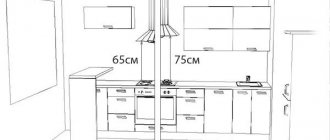Crown structure
A standard crown consists of the following elements:
- Shank . Fastening for inserting equipment into the chuck of an electric tool.
- Centering drill . The main guide for creating holes.
- Cutting attachment . A cylindrical “blank” with a jagged end.
Core drills with countersinks allow you to deepen the outer edge so that the socket box does not protrude even a millimeter above the wall surface.
Manufacturers produce cutters of two design types:
- Collapsible . All elements can be removed and any of them replaced.
- Non-separable . If something breaks or wears off, just throw it away.
According to the type of fastening, cutter shanks are divided into: triangular , hexagonal , SDS Plus and SDS Max . Before purchasing, you should find out which ones your hammer drill can work with.
Equipment dimensions
When choosing a crown, it is necessary to take into account the following dimensions of the socket, which we described in detail in the article:
- Installation diameter . If you have a 68 mm , then the diameter of the cutter for drywall and wood should be similar, and in the case of concrete, you need to add 3 - 5 mm for leveling and coating with alabaster or gypsum.
- Installation depth . Let's say the casing is 45 mm . This means that equipment with a drilling depth of at least 45 mm .
The range of sizes of core drills is large: on sale you can find products with a diameter from 33 to 150 mm .
Now let's talk about the types of crowns.
Types of socket boxes
Manufacturers make socket boxes from plastic, wood and metal. The last two types have lost their former popularity, since wood can only be used for installing open wiring, and iron boxes can cause a short circuit.
There are 4 options for mounting boxes:
Round. The most popular and versatile. Square. More spacious. Oval. Needed for installing two sockets or a socket and a switch in one casing. Composite. A block of 2 or more socket boxes connected into one structure.
Before purchasing a retainer, you should decide on its size.
3
Making holes
There are three ways to make a hole in the wall for a socket box. The choice depends on the available tool and the availability of certain attachments for it.
We recommend: Heating scheme for a private house with natural circulation - unaesthetic, but practical
To facilitate the work, a template strip for the socket block is made from aluminum. Its length should be equal to the number of rosette holes + 10 cm on each edge for fastening to the wall covering.
3.1
Method one
The hole is drilled using a hammer drill with a special attachment for concrete (stone, brick). The nozzle is chosen with a diameter of 70-75 mm depending on the size of the socket box 61 or 65 mm, respectively. If the nozzle is purchased before the mounting box, then it is better if it is larger - it is easier to fill voids with asbestos than to expand a small hole an additional millimeter.
Now you need to drill a hole according to the precisely calibrated markings. The drilling depth exceeds the depth of the socket box by 15 mm. The nozzle is a crown, so a finished hole will not come out right away; the drilling site will look like in the photo:
The next step is knocking out the core. This is done using a bolt or a chisel (a more labor-intensive method).
If during drilling it turns out that the fittings are passing through the places designated for the socket boxes (a characteristic grinding noise will occur), the installation will have to be rescheduled.
The standard pitch of the fittings is 15-30 mm; it will be enough to move the socket 5 cm and install it there. It is important to determine how the interfering fittings pass - vertically or horizontally, in order to know where to move the socket - up or down.
If it is impossible to move the hole for the mounting box, remove part of the interfering fittings. To do this, use a bolt to break the concrete around the reinforcement. Next, use a chisel to break the obstacle that has arisen (if the wire is no more than 6 mm) or drill it out, cut it out with a grinder (if the wire is thicker).
3.2
Method two
You can drill a hole using a drill with a drill bit. The method is quite labor-intensive, but quite suitable for the production of 1-2 nests. To do this, mark a 75 mm circle on the wall with a pencil, corresponding to the socket box (draw using a template). Next, holes are drilled along the contour, located as close to each other as possible. Then the middle is knocked out with a bolt.
You should not carefully monitor the integrity of the wall - this is a waste of time and effort. During any installation, final finishing is a mandatory final stage. The topcoat will still have to be applied.
Drilling holes for mounting a socket box using a drill is well suited for working on a brick wall and tiles. This is a lightweight material; all you need is a new Pobedit drill bit.
We recommend: Calculation of the required power of a gas boiler
3.3
Method three
Another drilling option is using a grinder. Cut out a regular rectangle (if there are several sockets) or a square (for a single product), adding a small margin.
It does not look aesthetically pleasing, but further plastering and finishing work will improve the appearance.
3.4
Additional method
Another option for drilling holes for socket boxes is using a hammer drill in jackhammer mode. This method is used extremely rarely. The procedure is similar to the previous methods: marking, making holes. Next, the finished nests are thoroughly cleaned with a vacuum cleaner or brushes and the obligatory primer is applied. The final version looks like in the photo:
Carbide
The cutting part of carbide bits is brazed from an alloy called “win” ( 90 % tungsten and 10 % cobalt). The main advantage is low cost, and the main disadvantage is the short service life. Such cutters are very vulnerable and must be treated with care.
This is the right choice if you need to make 1 - 10 holes for socket boxes in concrete or brick walls. The products are not suitable for large volumes.
When it comes into contact with reinforcement, strong teeth are broken out of the “blank”, especially in products made in Asia. Therefore, you should avoid reinforced areas .
Diamond
The active element of diamond crowns is a coating of natural mineral, which has no equal in hardness. Strong segments are laser welded on the edge of the cutter. They quickly cut concrete using fine diamond chips generated during operation.
Types of marking: M - only ordinary concrete, C - reinforced, T - high-quality.
The equipment is suitable for reinforced sections of walls, as it can easily handle metal. The cutter penetrates to any depth, leaves smooth holes and creates a minimum of noise.
Diamond bits are not designed to work in impact and combined modes. Set the rotary hammer switch to “ drilling only .
How tile crowns work
| The principle is based on a simple method of boring and drilling. The rim of the bit cuts into the tile and, under the rotation of the drill, gradually cuts off layers of material. As you can imagine, this friction produces a lot of energy in the form of heat. To prevent the material from cracking, you need to carry out all work at low speeds and press, but not hard, and evenly. |
Due to its hardness, a diamond tile bit can use the same principle to “cut” more durable materials, including metal parts of the wall, if you need to lay a cable to bring it to an outlet.
Materials that can be “cut” using crowns:
- Tile;
- Brick;
- Porcelain tiles;
- A natural stone;
- Plastic;
- Faience;
- Concrete;
- Tree;
- Metal.
The diamond crown for tiles can be produced in various versions.
The photo shows a tubular version and a standard crown with teeth. For one-time use, you can purchase a set of tile crowns in large hardware stores, but most often their quality leaves much to be desired. It is not clear where buyers get these kits from, but most often they break down faster than you achieve the result; even the attached certificate does not in any way affect the life expectancy of such kits. It is best to buy such sets from well-known brands, and even better if the tools from these manufacturers have excellent reviews.
| Do not work with tile crowns using an impact drill. With its help, you can only chip the slab, but you cannot drill it. |
Tungsten carbide
The main part is abrasive tungsten carbide coating . The chips on the edge of the cutter are so strong that they cope with such stubborn materials as ceramic tiles .
The ideal type of nozzle if you need to make a recess for a socket box in a tiled wall . You can work with brick and stone. The only disadvantage of the products is that the service life is much lower than that of a diamond crown.
You cannot drill through reinforced areas , as the cutting edge will become jagged and unusable .
How to make a hole in a tile for a socket
When processing ceramics, you can use a hammerless drill with a diamond attachment or a tungsten carbide cutter. Apply masking tape to the surface of the tile and mark the dimensions of the hole on it. Then apply the tool and drill at low speeds, periodically wetting the nozzle with water. The advantage of the carbide nozzle lies in the absence of the need for constant cooling.
Using crowns for sockets in concrete speeds up the electrical installation process and improves the quality of the work done.
Bimetallic
The bimetallic bit attachment consists of two welded parts. The cylindrical base is tool steel with a Rockwell hardness of 45 - 55 HRC , and the cutting edge is wear-resistant steel with a strength rating of 66 - 68 HRC .
This type of cutter is suitable for drilling holes in drywall , plastic and wood . They have low cost and a fairly large resource.
When working with drywall, be careful not to let the core bit touch the metal sheathing profile.
Pivot table
We looked at 4 types of crowns. It's time to sum it up. We present a summary table that shows the areas of application of cutters.
| № | Crown type | Concrete | Reinforced concrete | Ceramic tile | Drywall | Tree |
| 1 | Carbide | + | — | — | — | — |
| 2 | Diamond | + | + | + | — | — |
| 3 | Tungsten carbide | + | — | + | — | — |
| 4 | Bimetallic | — | — | — | + | + |
Standard crowns for socket boxes for concrete, plasterboard and wood differ in their characteristics. There is no universal option. But, using our recommendations, you can choose equipment with a decent ratio of cost and quality .
Good domestic crowns are the brands “ Zubr ” and “ Praktika ”. If you need something more reliable, you can purchase Messer , Bosh or Master Stayer .
What is the best crown for socket boxes - types and features of attachments
Sequence of installation of a socket box in a concrete wall
For effective drilling of cavities, it is important to choose the right working tool, taking into account the strength characteristics of the building material that will be processed. Depending on the task at hand, the concrete bit differs in the material of the cutting surface.
The following varieties are used:
- diamond crown for socket boxes installed in concrete;
- tungsten carbide attachment for processing brick and ceramics;
- tool with a cutting edge made of pobedit.
Let's look at each type in more detail.
Diamond crown for concrete sockets
The main feature of a working tool with diamond coating on the cutting edge is the ability to form cavities in a solid mass without impact. This technology allows for the correct hole geometry. Ideal surface cleanliness distinguishes the formed cavities from holes produced by tools with pobedite tips.
When working with diamond-coated nozzles, two methods of drilling concrete mass are used:
- with water supplied to the working area. Drilling is carried out with a professional tool;
- without forced cooling. Processing is carried out with a drill or a conventional hammer drill.
Diamond crown for concrete (sub-cutting)
Accordingly, each technological processing method is carried out with a different tool :
- diamond bits for wet cutting. The cutting segments are attached to the working head body using carbide solder. To maintain a stable temperature of the diamond bit, which heats up at an accelerated rate when in contact with concrete, water is supplied. This allows you to extend the service life and reduce dust formation. The working head is subject to restoration when worn;
- heads with a cutting edge made of diamond chips, which are capable of maintaining operational properties even with a significant increase in temperature in the cutting zone. This allows operations to form channels in concrete without supplying coolant. Such a drilling tool has an increased service life, but if the cutting ability decreases, it cannot be restored.
A socket crown with a diamond working part has a set of advantages:
- increased cutting ability, allowing you to cut reinforcing rods;
- reduced noise level, as well as the absence of dust when using the wet method of concrete processing;
- increased efficiency, as well as increased, compared to pobedit soldering, service life.
Due to its advantages, diamond tools are used when performing work both on an industrial scale and when performing repairs by private individuals.
Diamond bit for concrete and porcelain tiles PAZ 67 mm
It is also necessary to note the following advantages :
- preservation of the structure of building structures in the cutting zone;
- possibility of restoring wet-type nozzles.
The only drawback of a diamond crown for sockets is the increased cost. To maintain the tool in working condition, certain skills are required to perform the work.
Tungsten carbide crown for rosette in concrete
Strength characteristics, structure and manufacturing technology of the cutting edge allow processing of various materials:
- concrete without steel reinforcement;
- brickwork;
- ceramic tiles.
Features of the universal tool:
- no need to change attachments for processing different building materials. This allows you to speed up drilling operations;
- increased surface cleanliness of the formed cavity in the contact area of the cutter with the material. There are no irregularities or chips.
However, there is one significant drawback - the failure of an expensive cutter upon contact with steel reinforcement. In addition, efficient operation of the tool is ensured at increased rotation speed and increased power of the electric drill. A tungsten carbide concrete bit cannot be considered a universal tool, since it cannot be used for processing all types of building materials.
Tungsten carbide rosette bit
Pobedite crown for rosettes
This type of tool is widespread when performing work by private craftsmen and home craftsmen. The cutting edge is formed from a carbide material, which is used as pobedit or its analogues. The tool can be used in conjunction with an electric drill or hammer drill. The strength of the crown for a rosette in concrete allows it to be used in impact mode.
The main advantages of a pobedit cutter:
- low price of the tool;
- long service life;
- extended range of sizes.
Along with the advantages, there are a number of disadvantages:
- the difficulty of restoring pobedit soldering;
- breakdown of the working part of the tool when processing reinforced concrete.
Carbide bits for concrete have different sizes - from 3.5 cm to 12 cm, which allows them to be used for various construction work.
Crown for sockets on concrete – diameter of nozzles
Pobedit crown for sockets
When deciding which diameter of the crown for socket boxes is best to use, you need to know the size of the glass body for installing a switch or socket. The specified size is standardized and is 6.8 cm in diameter with a cavity depth of up to 4.5 cm. To ensure the convenience of electrical installation work, it is advisable to use a cutter with a working part diameter increased by several millimeters. A head with a diameter of 7–7.4 cm is suitable. The reduced diameter of the working part will not allow installing the cup holder into the drilled cavity and fixing it to plaster or alabaster.











